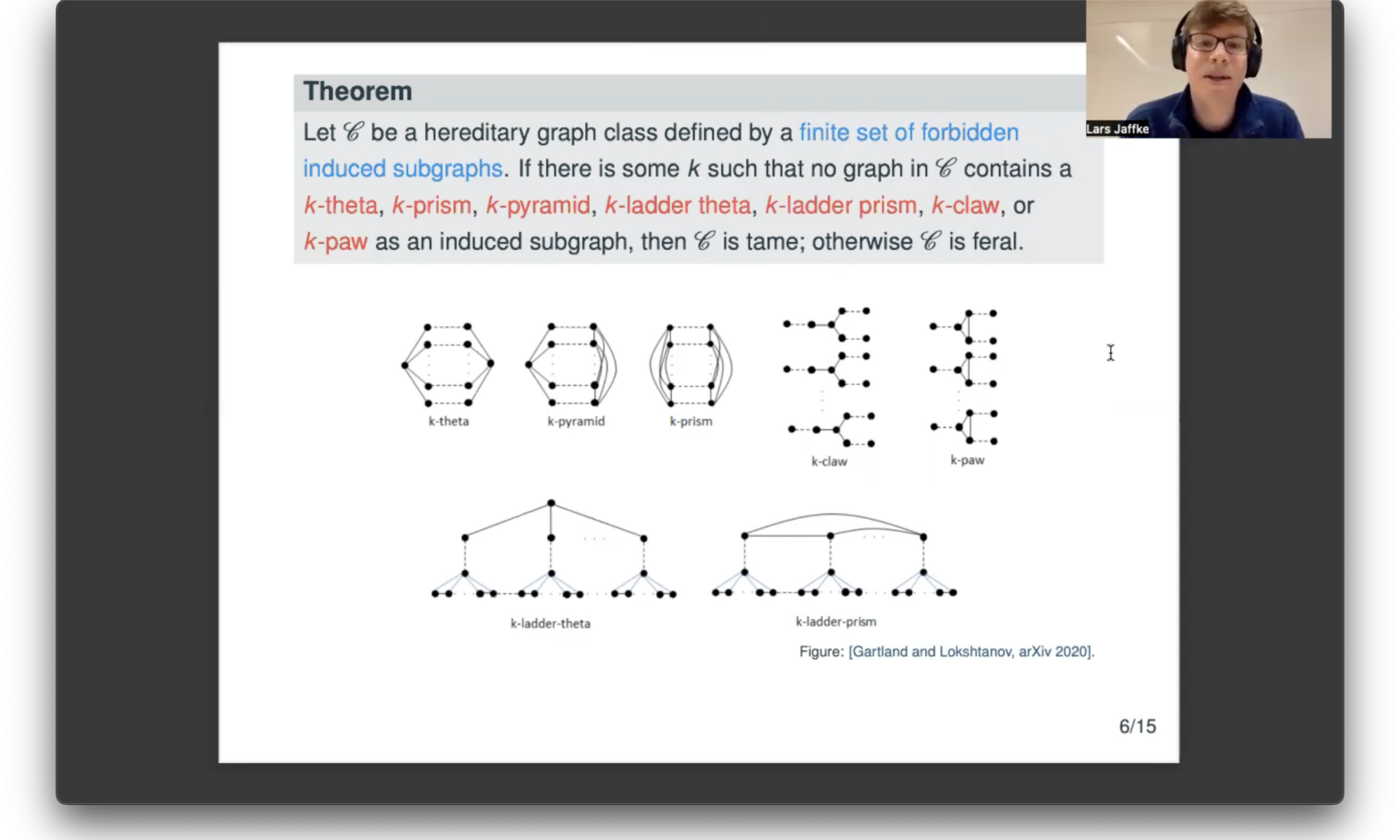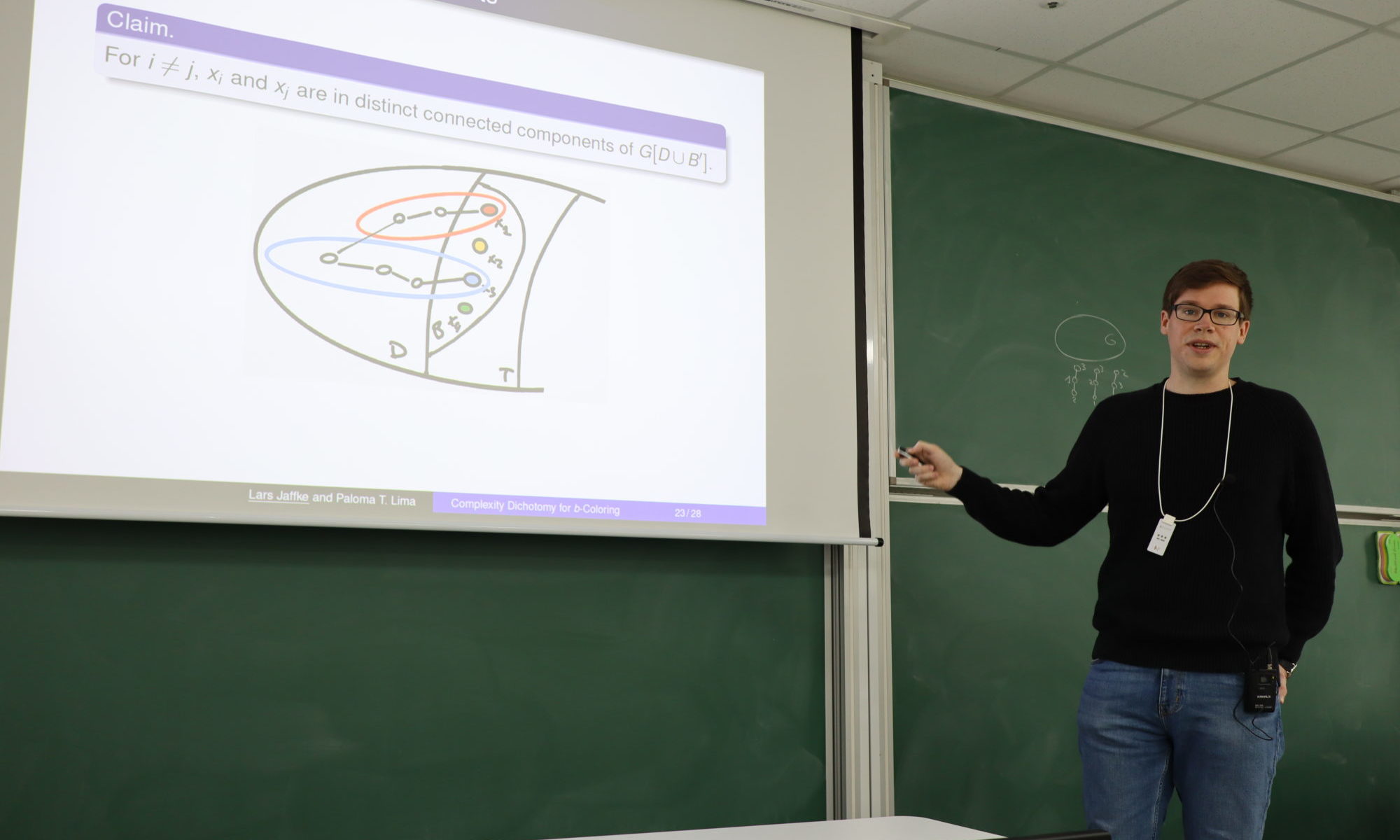On August 3, 2022, Lars Jaffke from the University of Bergen gave an online talk at the Virtual Discrete Math Colloquium on characterizing hereditary graph classes with polynomially many minimal separators. The title of his talk was “Taming graphs with no large creatures and skinny ladders“.
Lars Jaffke, Taming graphs with no large creatures and skinny ladders
We confirm a conjecture of Gartland and Lokshtanov [arXiv:2007.08761]: if for a hereditary graph class $\mathcal{G}$ there exists a constant $k$ such that no member of $\mathcal{G}$ contains a $k$-creature as an induced subgraph or a $k$-skinny-ladder as an induced minor, then there exists a polynomial $p$ such that every $G \in \mathcal{G}$ contains at most $p(|V(G)|)$ minimal separators. By a result of Fomin, Todinca, and Villanger [SIAM J. Comput. 2015] the latter entails the existence of polynomial-time algorithms for Maximum Weight Independent Set, Feedback Vertex Set and many other problems, when restricted to an input graph from $\mathcal{G}$. Furthermore, as shown by Gartland and Lokshtanov, our result implies a full dichotomy of hereditary graph classes defined by a finite set of forbidden induced subgraphs into tame (admitting a polynomial bound of the number of minimal separators) and feral (containing infinitely many graphs with exponential number of minimal separators).
Joint work with Jakub Gajarský, Paloma T. Lima, Jana Novotná, Marcin Pilipczuk, Paweł Rzążewski, and Uéverton S. Souza.
Lars Jaffke presented his work on the b-chromatic number of graphs at the Discrete Math Seminar
On May 20, 2019, Lars Jaffke from University of Bergen, Norway presented his work on algorithmic questions regarding the b-chromatic number of graphs at the Discrete Math Seminar. The title of his talk was “A complexity dichotomy for critical values of the b-chromatic number of graphs“.
Lars Jaffke, A complexity dichotomy for critical values of the b-chromatic number of graphs
A $b$-coloring of a graph $G$ is a proper coloring of its vertices such that each color class contains a vertex that has at least one neighbor in all the other color classes. The $b$-Coloring problem asks whether a graph $G$ has a $b$-coloring with $k$ colors.
The $b$-chromatic number of a graph $G$, denoted by $\chi_b(G)$, is the maximum number $k$ such that $G$ admits a $b$-coloring with $k$ colors. We consider the complexity of the $b$-Coloring problem, whenever the value of $k$ is close to one of two upper bounds on $\chi_b(G)$: The maximum degree $\Delta(G)$ plus one, and the $m$-degree, denoted by $m(G)$, which is defined as the maximum number $i$ such that $G$ has $i$ vertices of degree at least $i-1$. We obtain a dichotomy result stating that for fixed $k \in\{\Delta(G) + 1 − p, m(G) − p\}$, the problem is polynomial-time solvable whenever $p\in\{0, 1\}$ and, even when $k = 3$, it is NP-complete whenever $p \ge 2$.
We furthermore consider parameterizations of the $b$-Coloring problem that involve the maximum degree $\Delta(G)$ of the input graph $G$ and give two FPT-algorithms. First, we show that deciding whether a graph G has a $b$-coloring with $m(G)$ colors is FPT parameterized by $\Delta(G)$. Second, we show that $b$-Coloring is FPT parameterized by $\Delta(G) + \ell_k(G)$, where $\ell_k(G)$ denotes the number of vertices of degree at least $k$.
This is joint work with Paloma T. Lima.



